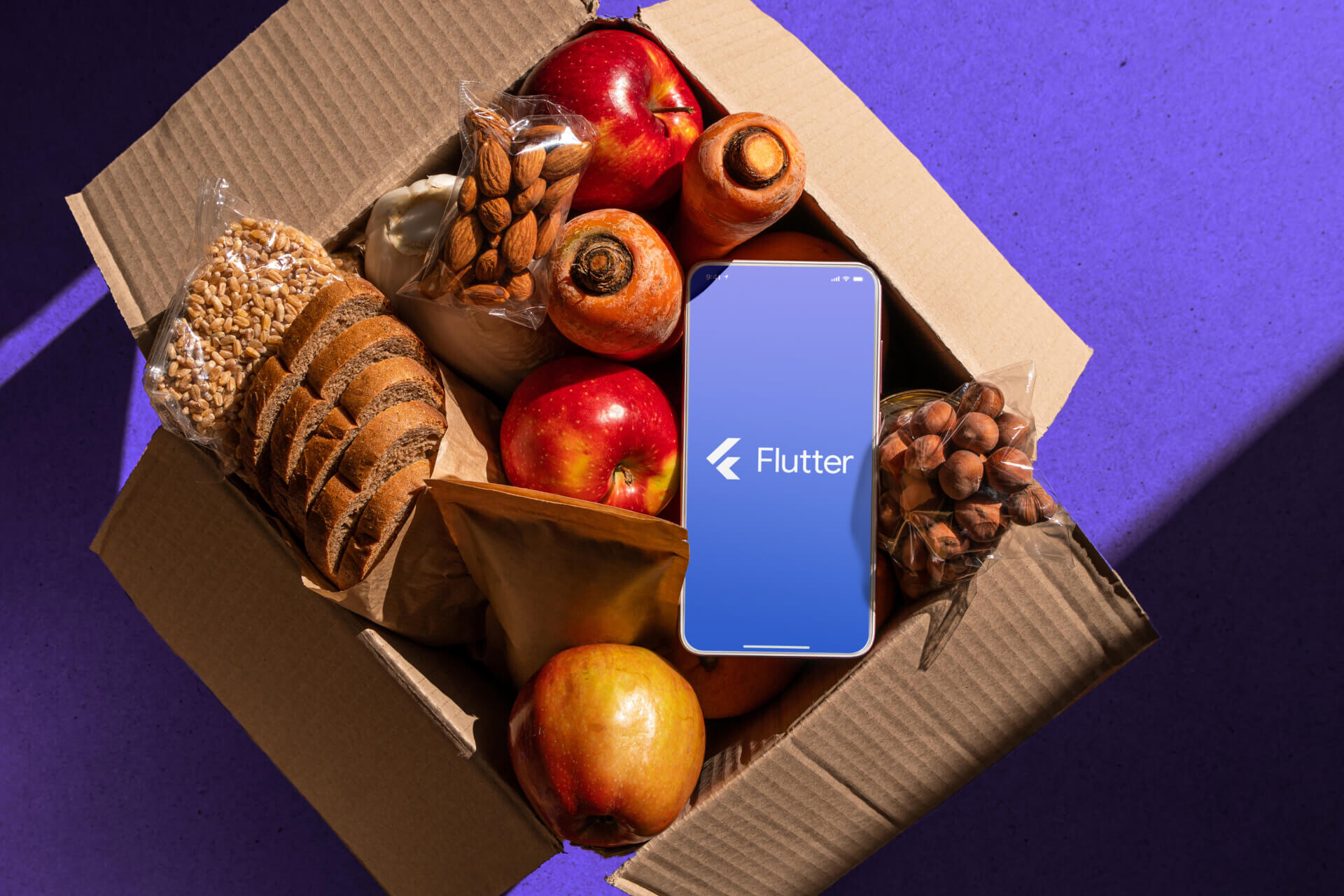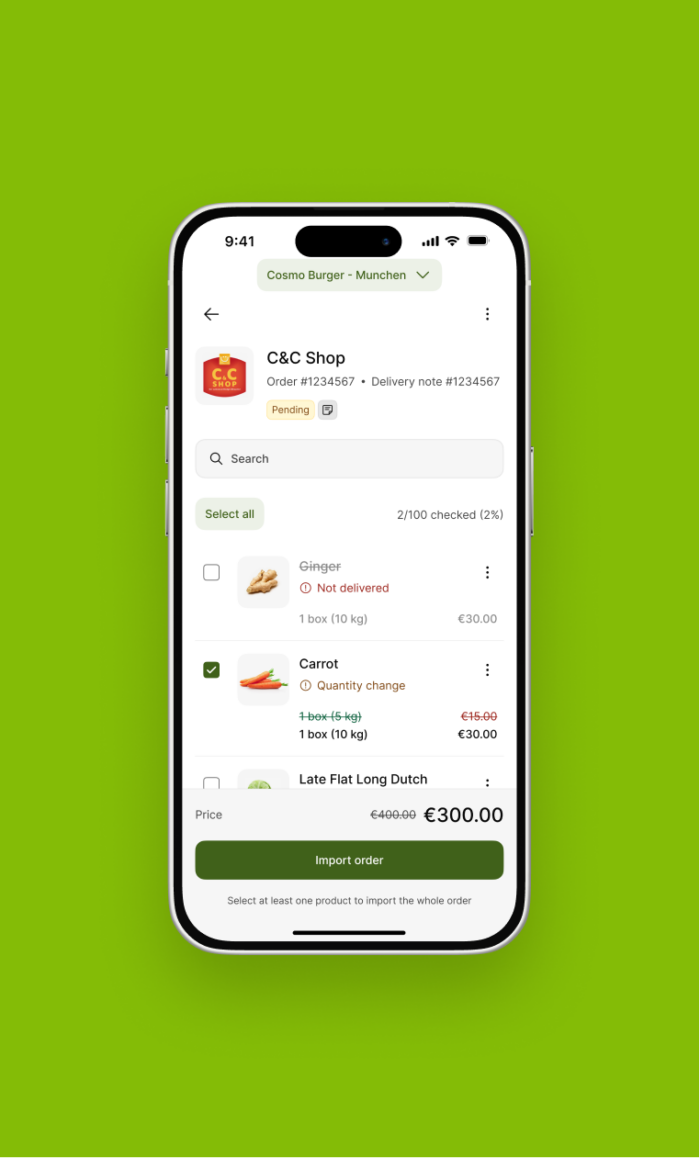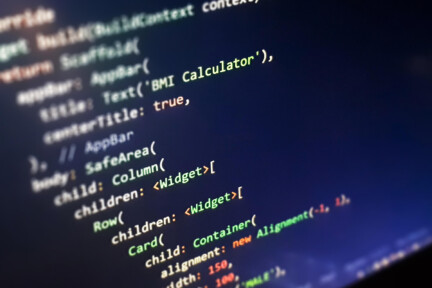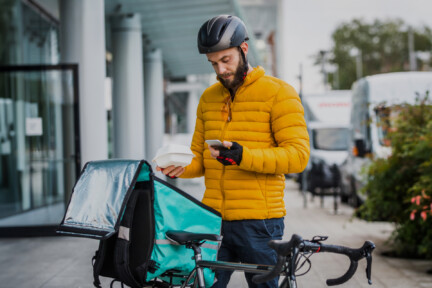The online food delivery market is booming. And not just for food delivery marketplace apps like DoorDash and Uber Eats. Restaurants, supermarkets, and cloud kitchens are creating branded apps to meet Millennial and Gen Z demand for convenient, prepared meals.
The timing couldn’t be better. Projections show market growth of 2.5 billion of food app users by 2028, with a market value of $1.79 trillion. The question isn’t if you should develop a food delivery app. You definitely should. It’s how you should do it.
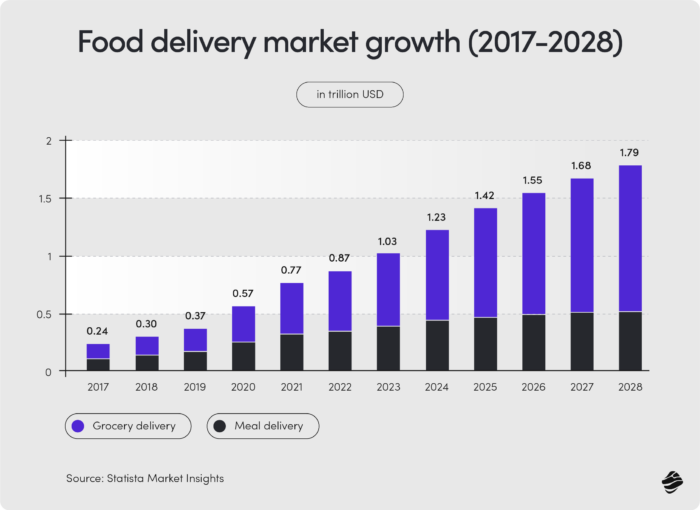
This article explores Flutter for food delivery app development. You’ll gain insight into its technology and discover real-world cases of Flutter apps.
Introduction to Flutter
Flutter is an open-source framework developed by Google. It enables restaurant app developers to build and deploy high-quality mobile, web, and desktop applications for multiple operating systems using a single codebase.
Instead of separate development cycles for iOS and Android apps, developers can create one food delivery app in Flutter that works on both. One code to rule them all.
The foundation of Flutter is Dart, a programming language created for fast app development.
Key Flutter features include:
- Hot reload: allows users to view code changes in real time.
- Customizable widgets: adapt the app’s appearance to the appropriate platform.
- Open-source community: provides extensive resources, including third-party plugins.
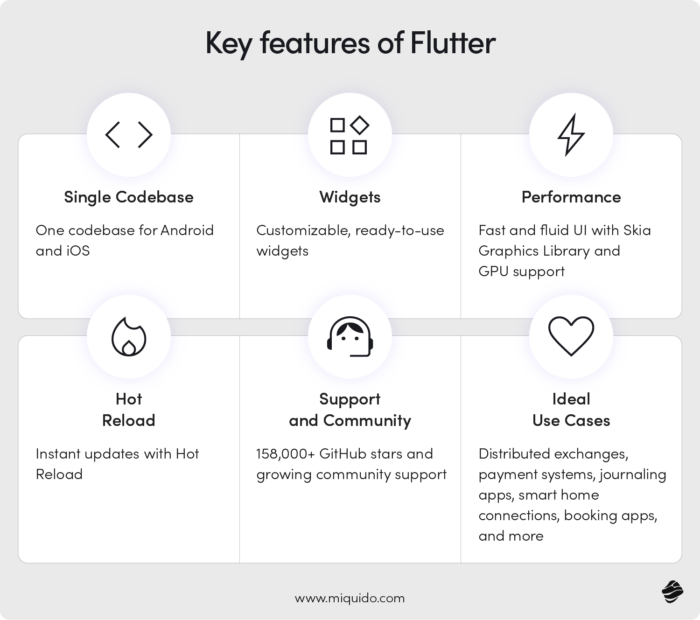
These features work together to deliver development efficiency and native performance for brands like Google, Alibaba, and BMW.
Why choose Flutter for food delivery apps
Flutter is ideal for food apps because it delivers robust cross-platform solutions. Using a single code for iOS and Android platforms shortens the development cycle, saving time and money. It also ensures consistency across platforms, simplifying maintenance.
The benefits of Flutter include:
- Fast development
- Cost efficiency
- Native performance
To understand these advantages better, let’s compare Flutter to native app development.
| Flutter | Native (Swift – IOS & Kotlin – Android) | |
| Speed | Single code for Android and iOS applications, resulting in faster development cycles. | Platform-specific codes, resulting in separate and potentially slower development cycles. |
| Cost | A single codebase minimizes development and maintenance costs. | Separate codes double development and maintenance costs. |
| Performance | Incorporates critical platform elements (icons, fonts, navigation) for a native-like experience. | Provides native performance with apps developed and optimized for specific platforms. |
With Flutter, you can create high-quality, native-like apps faster and cheaper.
Flutter isn’t the only cross-platform app developer in the market. But it is the most popular. Check this out.
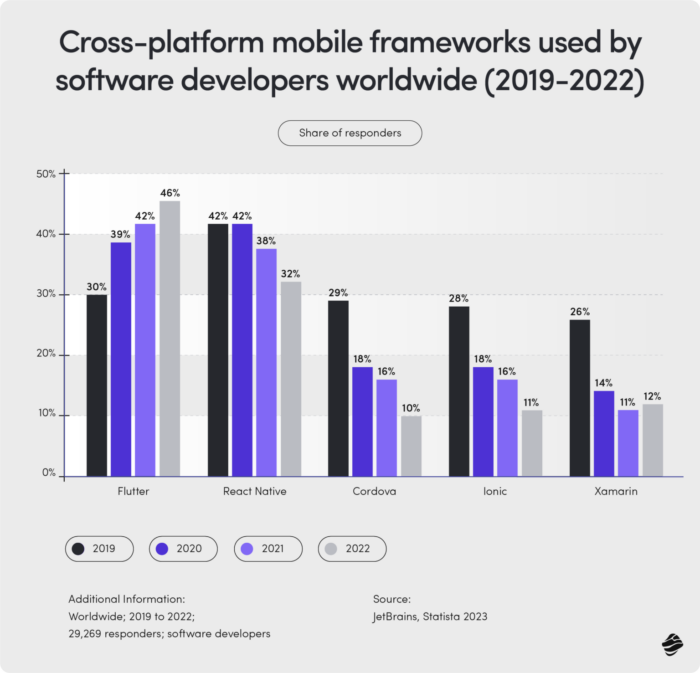
46% of software developers use Flutter, followed by other Flutter alternatives like React Native (35%) and Cordova (10%).
Flutter’s closest competitor is React Native, an open-source framework developed by Meta. Its advantages over Flutter are:
- it uses JavaScript (a widely known programming language)
- has a more established community
- has a more comprehensive integration ecosystem.
However, Flutter wins on performance since its programming language complies with native ARM code, while React Native requires a bridge to connect its JavaScript to native code.
User interface and experience
Flutter builds apps using a library of pre-designed widgets. You can create a Flutter food delivery app to fit any design requirement, from layout to the navigation menu.
The development kit provides Material Design (for Android) and Cupertino (for iOS), which adapts widgets' appearance to match each platform's look and feel. That ensures a consistent user experience for Google Play and Apple Store customers.
Customization doesn’t end there. Developers can customize individual widgets. For instance, they can create custom animation for individual widgets using Flutter’s motion APIs.
What UI components do top food delivery apps have?
- Profiles
- Menu items
- Product details
- Ordering
- Payments
- Tracking
- Notifications
- Support
- Ratings & reviews
Now check out the food app template below.
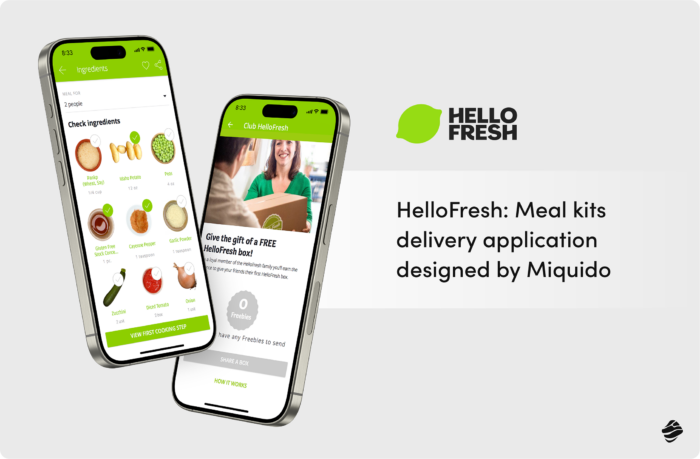
Miquido created a food delivery app for HelloFresh that's compatible with both Android and iOS. This app lets users easily plan meals, make choices, and order food. It also includes an admin panel for efficient backend management.
Learn more about the HelloFresh food delivery app by reading our case study.
Performance and efficiency
One of Flutter’s key selling points is its performance. It provides 60 fps (frames per second), matching native app performance. The high frame rate ensures a smooth and responsive user experience.
Flutter achieves that outstanding performance in various ways, including through its programming language. Dart supports Ahead-of-Time (AOT) compilation, which makes food delivery Flutter apps faster since the code runs natively on each platform.
But why 60fps? It’s the sweet spot to show fluid motion. Higher frame rates don’t offer significant differences. The goal is to keep the app at 60fps. Inconsistencies in the frame rate are noticeable, causing tension and uneasiness in users.
So, track app performance using the following metrics:
- Jank
- Download size
- Startup time
- Battery efficiency
Changes in these benchmarks tell you when there’s a performance regression.
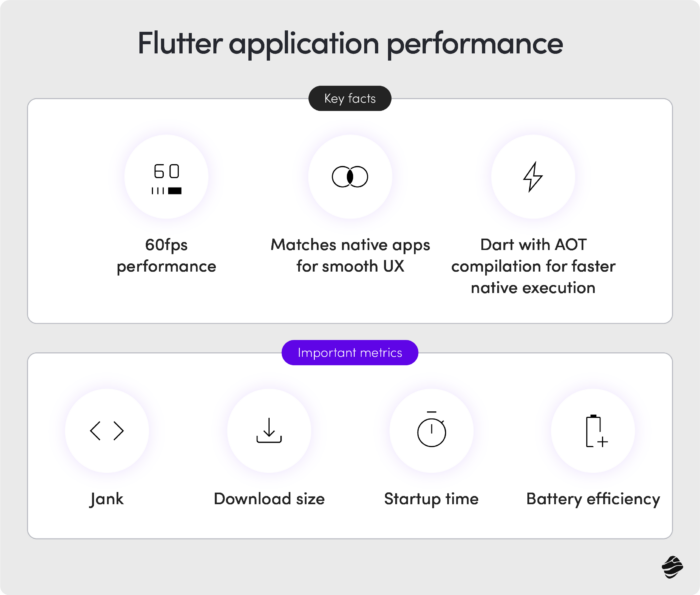
Flutter can help you cut corners into better user experience, as our experience proves. In our foodtech project for Foodnotify, high performance, even in low connectivity, was one of the priorities. The app, already written in Flutter, gained stability and performed even better after executing our targeted refactoring and tech modernization plan. Symfony, PHP, and Flutter update enabled Miquido to eliminate recurring errors and make the app work even smoother.
Development speed and cost efficiency
Flutter accelerates the app development process. Don’t just take our word for it. 91% of developers say Flutter reduces app development time.
Development speed and cost efficiency go hand-in-hand. A shorter time-to-market means you’re making money sooner.
Moreover, since it uses the same code for iOS and Android apps, your Flutter app development cost is significantly less. You don’t need separate teams or projects to create and maintain apps.
The features that facilitate Flutter’s rapid development speed are:
- Hot reload: When developers create or update a native app, they’re sometimes forced to compile and restart the code to review the changes. Hot reloading enables code changes in real time without restarting the application. The instant feedback cuts build time and makes experimenting easier.
- Ready-made widgets: Developers can quickly build apps from Flutter’s widget libraries, reducing time to market while providing consistent user experiences.
Another way to increase development speed and minimize costs is to outsource to a food delivery app development company. You save overhead and labor – two of your biggest cost centers. The final budget varies per project, but you can expect to save 30% - 40% compared to native app development.
Integration with Backend Services
Integrating backend services is crucial when developing a food ordering app in Flutter. It allows the app to perform essential tasks such as data management, user authentication, real-time syncing, and more.
Flutter can integrate with existing platforms, backend services, and APIs, allowing food delivery businesses to streamline operations and provide seamless experiences. It does this with packages.
Flutter packages are libraries of code that allow you to add specific functionality to your app. They speed up the development process and reduce how much code you need to write.
Flutter’s ecosystem has thousands of packages and plugins, including libraries for order management, payment gateways, and real-time tracking.
One such package is Pay, which integrates Apple Pay and Google Pay for frictionless transactions.
Other popular third-party packages include:
- Dio: HTTP client for handling network requests
- url_launcher: launches URLs in mobile platform browsers
- order_tracker: offers animated order tracking
- firebase_database: provides real-time data syncing with Firebase backend services.
If you don’t find a package and API, you can create one for your business software and databases.
Community and Ecosystem
Flutter has an open and active community. It provides tutorials to help beginners get started and find help when needed. Developers can network on Discord, Reddit, Slack, or Meetups. Flutter also hosts virtual and in-person events like the challenges and conferences.
Flutter’s global community contributes to its ecosystems by developing and sharing third-party packages and plugins. That increases the number of development tools available, adding support and resources.
Real-world Flutter Food Delivery Apps
Flutter is responsible for many of the apps you use and love. Some of the best apps made with Flutter are Google Ads, Hamilton (the hugely successful Broadway play), and Xianyu by Alibaba.
Below are two examples of food apps created with Flutter.
Lunching
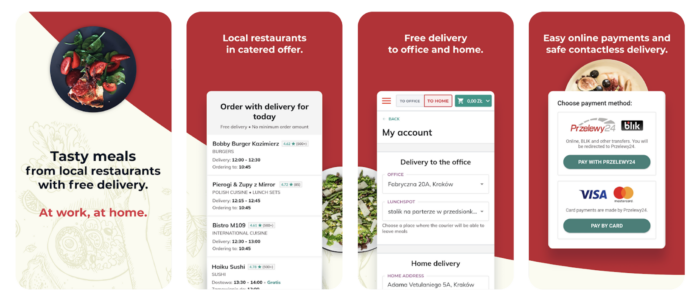
Lunching is a corporate food delivery system. It allows businesses to organize delicious and healthy meals for employees. It’s a virtual canteen for office, logistic, and industrial employees. The company or individual employees order meals for a set delivery time.
The app’s development team tried Flutter as a research and development exercise. They wanted to see if Flutter worked as well as native frameworks, and it did. They also found the programming language easy to learn.
A favorite feature was Hot Reload, which allowed them to experiment extensively. Flutter’s ecosystem meant they didn’t have to build a customer backend because the framework integrates with mobile backend-as-a-service (MBaaS) platforms like Firebase.
Caribou Coffee
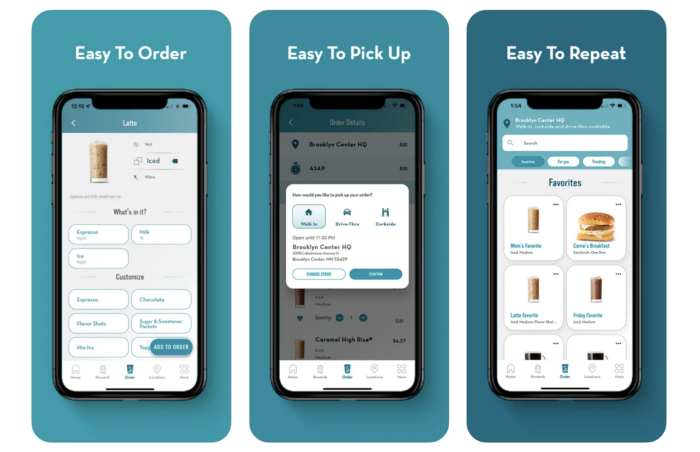
Caribou Coffee makes ordering drinks easy and convenient with their app. Customers choose what they want and how to collect – in-store, drive-through, curbside, or delivery.
Caribou’s app went through multiple iterations. The first was Titanium, which had a high crash rate and clunky mobile experience. The second iteration involved Swift and Kotlin for native performance. However, maintaining two apps was time-consuming.
Caribou migrated to Flutter after reviewing several cross-platform development services. Like Lunching, Caribou’s native app developers found Dart easy to learn. The company liked Flutter’s flexibility, developer efficiency, and seamless integration with tools they already use.
Challenges and Considerations
Using Flutter for food delivery app development is fun and exciting. But, it has challenges.
Learning Curve
Flutter’s programming language isn’t used outside of Flutter and, therefore, widely unknown. According to the 2023 Stack Overflow survey, only 6.02% of developers are proficient with Dart. That means most developers must learn Dart, which can impact project timelines.
Solution: Fortunately, Dart is easy to learn. Start with Flutter’s official documentation and tutorials.
You can also join Flutter’s community forum and learn from fellow developers. Given the popularity of Flutter app development services, online courses won’t be a wasted investment.
Limited Resources
Flutter is still young, and the number of third-party libraries and plugins is less than in older development frameworks. That poses a problem for developers with specific functionality requirements not found in core libraries.
Solution: Developers can build custom solutions, contributing to Flutter’s ecosystem.
Design Consistency
Flutter’s widget library mimics native UI components but subtle differences can lead to inconsistencies in your app’s look and feel.
Solution: Developers must collaborate with designers to create adaptable style guides for a consistent user experience.
App Size
Flutter apps are large because their files contain the Flutter engine. The bigger the app, the more space it takes and the more time it takes to download.
Solution: Use Flutter’s AOT compilation to decrease startup times and improve performance. You can also minimize code to reduce load times.
Flutter also presents some scaling and maintenance challenges. Scalability isn’t only about handling user growth, data volume, or feature expansion; it also involves maintaining code that is easy to test, debug, and understand.
Flutter doesn’t enforce specific code structures or schemes, which means you need to establish robust code architecture from the outset. Achieving high code coverage through testing is crucial to avoid ending up with unmanageable and unscalable code.
The Flutter community offers several recommended patterns and practices (like BLoC, Riverpod, and Redux) that can guide developers in creating maintainable and scalable applications.
You should also follow best practices in Flutter app development, such as consistent naming conventions, to ensure your code is clean and works as expected.
Future of Flutter in Food Delivery App Development
Flutter continues to evolve with new features to enhance developer productivity and user experience. These include:
- Web and desktop apps: Flutter 3 supports the development of web, Windows, Linux, and MacOS apps, creating opportunities to reach desktop users.
- Artificial intelligence and machine learning: Real-time analysis of user preferences, order histories, and customer behaviors provides customized and highly accurate food recommendations. AI integration can also help automate app operations such as code generation, testing, and optimization.
Furthermore, Flutter’s ecosystem and community will grow as it matures, offering more plugins that will benefit the food delivery industry. Backed by Google, you can expect continuous improvement in features and functionality.
In Closing
Many startups and established companies choose Flutter to develop their web, desktop, and mobile applications. The framework is a comprehensive solution for high-performing, visually appealing, user-friendly apps that operate on multiple platforms.
The single codebase, ready-made widget library, and hot reload feature decrease development time and costs, making it the ideal choice for competitive food brands with short time-to-market cycles.
Flutter is a major player in the app market. Let our skilled Flutter developers deliver high-performing apps for food delivery that set you apart from the competition. Contact us today!

